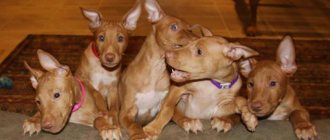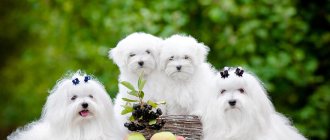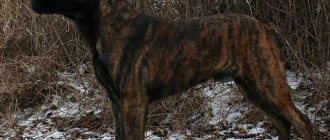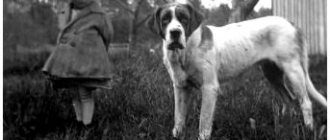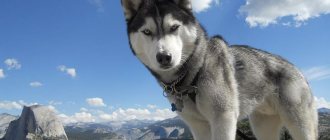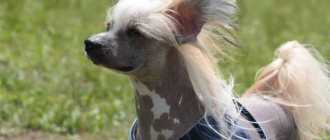| Origin | Danish Greenland |
| Usage | sledding |
| Color | two-color or one-color, except completely white |
| Dimensions | females not lower than 55 cm, males – from 60 cm |
| Lifespan | up to 14 years old |
The North Greenland dog belongs to a group of working dogs that are still actively used today. The breed is popular in the Arctic regions, but is rarely found outside of them. These hardy animals with good health, hunting instincts and irrepressible energy can make excellent companions. Sometimes these dogs are called Eskimo huskies. But this is the name of many representatives of northern sledding breeds; it is more correct to call them Greenland or Greenlandshounds.
Brief characteristics of the Greenland dog breed
- Other possible dog names: Greenlandshund, Greenland Husky, Gronlandshund, Greenland Dog.
- The height of an adult dog can reach 64 cm, and that of a female dog – 60 cm.
- Weight: 30-32 kg.
- Characteristic color: the coat color of the Greenlandshund is allowed to be any color, with the exception of absolutely white.
- Coat Length: Sufficiently long all over the body, with the exception of the paws and head. The undercoat is dense, thick, and soft.
- Lifespan: about 13-15 years.
- The advantages of the breed: endurance, good sense of smell and versatility - they can be used not only as sled dogs, but also for hunting or as companion dogs.
- Difficulties of the breed: it is difficult to keep in an apartment, because these dogs are born hard workers who, in addition to constant employment, require spacious walking and freedom.
- How much does it cost: 650-700 dollars.
History of the origin of the Greenland dog
The Greenland dog (Greenlandshund) is an ancient sled dog and now one of the rarest breeds of dogs capable of surviving in the most difficult arctic conditions.
There are legends that the direct ancestors of the Greenlandshunds were wolves who mated with Eskimo dogs - this is evidenced by the behavior of the dogs, similar to the behavior of wolves in a pack. The exact origin of the Greenlander is shrouded in mystery, but it is known that the breed was bred specifically for work in Arctic conditions - towing sleds, hunting bears and walruses. There is a version that the ancestors of the Greenlandshunds lived in Siberia and eventually migrated to Greenland - this happened in the 17th century.
Purpose and character of Greenlandshunds
If initially the dog was bred for certain purposes, such as transporting goods, hunting , now Greenlandshunds can most often be seen only among fans of the breed and athletes involved in sledding with dogs, and less often among hunters. It’s definitely not worth getting a Greenlandshund as a “sofa dog” - lack of work will not bring this dog any joy.
The Greenlandshund is a balanced, calm, but at the same time quite energetic dog. She is able to work tirelessly, run, and carry heavy loads . This is a friendly dog and is not aggressive towards humans, which does not allow it to be used as a guard.
The first impression of the Greenland dog is that it is indifferent to everything, but this is far from the case. She watches her master vigilantly and is happy to serve him, but she will never jump around him expressing her joy - rather, she will show it in another way: by doing her job well. The Greenlander cannot be called loyal: at the first opportunity he will run away from his owner and will not be too upset - the Greenlandshound is prone to vagrancy .
The Greenland dog gets along well with all family members , but the owner always needs to remind it who is boss in the house, since this dog is prone to dominance. That is why, in a dog group, the Greenlandshund can often become the main instigator of a quarrel.
Due to the fact that this dog was previously used as a hunting dog, it will be difficult for her to get along with small animals (cats, birds) in the same house.
B
Basenji
These are true companions for humans, as they easily and quickly become attached to their owner and the rest of the family.
Basset Hound
This is a dog with enormous intellectual capabilities, but at the same time loves to be loved and respected. They have a very calm disposition and do not require serious physical exertion.
Bedlington Terrier
It has a unique appearance, but at the same time the dog is distinguished by the presence of pronounced hunting instincts, while possessing a sense of self-esteem.
White Swiss Shepherd
A guard dog breed, therefore, it has all the characteristics inherent in this function. Does not show aggression towards strangers and animals, including dogs.
Belgian Griffon
It is an indoor decorative breed, but is distinguished by its unique development with a change in character. When a dog is young, it is rather weak and inactive. As an adult, she gains weight as well as muscle mass and subsequently becomes active and cheerful.
Belgian Shepherd
The dog is quite smart and has excellent security characteristics. She has a lively and intelligent look. However, it is not recommended for maintenance by inexperienced or indecisive owners.
Bernese Mountain Dog
This dog has many positive characteristics. This is not only a strong and hardy breed, it is very devoted to its owner and has a good-natured disposition.
Biewer Yorkshire Terrier
A decorative dog breed with a balanced temperament, but at the same time with a strong and strong-willed character. Feels great in the home company of people and animals.
Beagle
At one time, the breed of dogs helped people hunt small but nimble animals. The dog is friendly, smart, affectionate and energetic.
Bichon Frize
This is a naturally cheerful and playful dog. In addition, she is brave and non-aggressive, but at the same time she has a complex disposition that requires education and training.
Bloodhound
This is a true hound breed, extremely active, requiring constant physical activity. Otherwise, he will be able to turn the apartment into a trash bin.
Bobtail
Bobtails, despite their (comparatively) intimidating appearance, are distinguished by their friendly nature and loyalty towards family members.
Bolognese
The appearance of this breed is very attractive and interesting. They love their owners, but are distrustful of strangers.
Border Collie
The breed is an extremely energetic and fast-moving animal, and therefore requires constant physical activity.
Dogue de Bordeaux
A fairly ancient French breed, the ancestors of which are Roman fighting dogs. This breed was originally used to protect human settlements from wolves and bears.
You can't tell by its appearance that this dog has a very friendly character.
Beauceron
The breed is distinguished by the fact that it is quite social, since it is distinguished by its friendliness, both to its relatives and to other animals. The intelligence of this dog is at a high level.
Boston Terrier
This is a dog that has absorbed a lot of both positive and negative qualities. Needs qualified education and training.
Brazilian Fila
Can successfully protect an object that a person has entrusted to him. Shows distrust of strangers and even at exhibitions keeps everyone at a distance, including judges.
Brussels Griffon
Despite its small size, the breed knows its worth, but at the same time they show friendly feelings and love to play.
Bullmastiff
The breed is distinguished by boundless devotion to its owner, but at the same time they behave non-aggressively towards family members, acquaintances and friends, and are wary when meeting strangers.
Bull Terrier
A rather capricious and stubborn dog, therefore it requires a qualified approach to training and education. In addition, bull terriers must be constantly monitored, otherwise they will try to independently expand the boundaries of what is permitted.
Boerboel
These are strong and hardy dogs, with a beautifully built body that requires constant physical activity. For them, daily walks of 5 km are the minimum load.
How to choose a Greenland dog puppy
Choosing a puppy is a difficult and responsible matter, because you and your pet will then live together for many years, and therefore you should not take a dog from just anyone and anywhere. Avoid visiting bird markets; it is best to start by studying all the available information about the breed you have chosen, and then find a good breeder or nursery that breeds Greenlandshunds.
It is best to adopt a puppy when it is at least 2 months old - during this period the baby has already learned everything he needs from his mother, and therefore it will be easier for him to get used to his new home. You can take a grown-up puppy, but remember: the Greenlandshund is a dog for experienced owners.
Externally, Greenland dog puppies are somewhat similar to wolf cubs .
Feeding
Portion sizes are adjusted depending on the time of year and overall activity. Be sure to increase the caloric intake for working dogs, especially in winter, which requires greater expenditure of body heat.
Puppies are fed small but frequent portions about 6 times a day, and adult animals need 2 full meals.
A natural diet is based on:
- meat and offal;
- sea fish, boned;
- eggs;
- fermented milk products (cottage cheese, kefir);
- cereals (rice, buckwheat) and vegetables.
To avoid vitamin deficiency, give your pet chicken legs and necks enriched with calcium, phosphorus, zinc and iron. It is also important to avoid an abundance of carbohydrates, which lead to obesity with little physical activity.
There are no dry foods designed specifically for Greenland dogs, so when choosing dry food, consult your veterinarian.
Keeping and caring for the Greenland dog
The Greenland dog is not a lap dog and certainly not a couch potato. Keeping such a dog in an apartment is contraindicated - without proper exercise and lack of work, it will simply wither and begin to spoil your things.
The ideal place to live for such a dog is a country house with a vast territory where the dog can run around, and walks should be accompanied by regular intense training . At the same time, just running after a ball is not enough for the Greenlander - it is best to engage in agility, running or sledding with him.
Content Features
The Greenland dog is not suitable for home keeping and is categorically not recommended for apartments or cities. It is adapted for cold climates and constant work. At home, dogs are kept in spacious enclosures or on a leash near a kennel. Free keeping is fraught with escapes, uncontrolled matings and regular clashes between dogs. Thanks to their dense undercoat, they sleep calmly in the snow in severe frosts, but do not tolerate heat well.
Greenland dogs need to spend a lot of time outdoors, so they are not suitable for apartment living.
It is believed that Greenland dogs are better off not living alone. And if they are not kept with other sled dogs, then they should at least live with dogs of other large and medium breeds. Small people are usually not perceived as equals.
Care
Caring for Greenland dogs comes down to periodic brushing, examination, cleaning the ears and trimming the nails, which often do not have time to grind down on their own. They shed very profusely, in patches, once a year - in the spring, after the end of frost. Autumn molting is moderate.
Show dogs are rarely bathed; domestic sled dogs are generally not bathed.
Nutrition
Nutrition should be balanced and complete with a normal content of protein, fats and carbohydrates. It will allow puppies to develop properly, and adult dogs to maintain tone and sufficient muscle mass for hard work.
The ability to survive with a minimum of provisions is a thing of the past for them. Today, dogs are fed dry ready-made food or natural products, porridge is prepared in meat or fish broth, and they are given meat, offal, fish, and dairy products. Vitamin and mineral supplements are regularly introduced into the diet.
Training and education of the Greenland dog
The Greenland dog is quite intelligent and submissive, but will only obey one person, whom he recognizes as the leader and master. It is best if you have an experienced dog handler , since training a Greenlandshound can cause difficulties: this dog is prone to dominance and requires a special approach - it does not tolerate rough treatment.
You should start training your Greenlandschound puppy from the very first day he arrives in your home.
Mexican Hairless Dog (Xoloitzcuintle)
Oddly enough, but based on the name, the Mexican dog comes in two types: hairless and covered with hair. The latter also belongs to the breed of hairless dogs. Both may be present in one litter.
The Xolo dog, as I sometimes call it, was very respected and revered by the Aztecs. But in Europe it was not welcomed until the middle of the twentieth century.
The dog is very active and mobile. Therefore, it is necessary to deal with it from an early age.
The owner must inspire authority in the dog, otherwise there is a risk that it will turn into an unbalanced individual prone to dominance. She is very loyal to her owner, treats other family members evenly and does not tolerate strangers. If the dog gives a voice, it means something has happened, and it’s worth checking what he’s worried about.
Full description: Mexican Hairless Dog
Owner reviews of the Greenland dog
Inna:
This dog breed is very hardy, we run many kilometers with it without any problems. She is very kind - my children have a wonderful time with her. A strong, fearless character, the Greenlandshund is an excellent family companion. Lives in an apartment, but we study a lot. The only downside is that there is wool everywhere, but that doesn’t bother us.
Frey:
My girl is my beloved and best friend! In addition, she is very strong - together with her we have participated in various sledding competitions more than once and often won. And all thanks to her!
Interesting facts about Groenendaels
When breeders bred this breed of dog, the emphasis was on endurance and intelligence. Initially, these dogs could herd sheep on their own without the supervision of a shepherd, but later they began to be used for guard duty. They dogs have many amazing features.
- Groenendaels get along well with children and pets. They do not show aggression towards those who are smaller than them, even if a medium-sized dog will behave aggressively. Groenendaels easily find a common language even with cats;
- Groenendaels are very energetic, so when purchasing a breed you should take this fact into account. She needs to be walked frequently and given vigorous exercise. Otherwise, all the dog’s energy will be directed to the furniture in the apartment and to household members;
- Training for this breed begins at an early age. For example, a puppy knows the command “fetch” already at one and a half months. Groenendaels understand perfectly well what a person wants from them, but which commands they may refuse to carry out because they consider them boring and useless;
- These dogs are very independent. In a critical situation, Groenendael himself reacts to danger without human command;
- These freedom-loving dogs are prone to running away, so it is better to keep the dog in an enclosure and walk it only on a leash;
- Groenendaels are touchy and emotional. If the dog does not obey, then you can pointedly ignore it, and the dog will quickly understand its mistake.
After all, Groenendaels are owners. They are loyal to their owner and do not want to share him with other animals and people.
Greenland dog: description of the breed, character, care and reviews from owners
The Greenlandshund, or Greenland dog, is a northern breed that was registered relatively recently. It is believed that these dogs appeared quite a long time ago; they are even called one of the most ancient. Some researchers suggest that wolf blood also flows in the veins of Greenlandshunds, since the behavior of these animals is largely similar.
Greenland dogs are strong, resilient, and thrive in low temperatures. They can be sled dogs or hunters, but what they definitely don’t like is inaction. The Greenlanders definitely need something to do. Such a dog is not suitable for an apartment; it needs freedom, space and constant exercise. But for a farmer, hunter, forester or explorer of northern latitudes, the Greenlandshund can become not only a faithful friend, but also an ally.
How much do puppies cost?
Greenland dogs, due to their rarity, have a high cost, which depends on the purity of the pedigree, working diplomas of the parents, the age of the puppies and their class.
When looking for a companion, you should focus on pet-class babies, which have the disadvantages of the breed, but cost about 45 thousand rubles. A breeding class available for subsequent breeding will cost 160-300 thousand. But a puppy from champion parents that fully complies with the international standard can have a price of more than 300 thousand.
Nurseries
The bulk of Greenland dog breeders are concentrated in their homeland, Scandinavia and Canada. You can buy the puppy you want abroad, but in no case from a photo on the Internet. In Russia there is one breeding nursery “Zhano”, located in Moscow, where you can buy a small Greenlander or Alaskan Malamute (https://vk.com/malamuts_zhano).
Greenland huskies with a Nordic character are perfect for lovers of outdoor activities and exciting sled racing. Low maintenance requirements and endurance even in the harshest climates make them reliable companions for residents of northern regions.
History of the breed
It is not known exactly where Greenland dogs originated. Presumably their ancestors lived in Siberia, and in the 17th century they somehow ended up in Greenland. The number of Greenland sled dogs is small. In European countries they can not be found very often. Even in Scandinavia there are very few Greenland dogs. Export from Greenland is not prohibited, but the breed has not become widespread due to the peculiarities of its keeping: the dog needs cold and labor.
There is a version that these animals appeared as a result of crossing an Arctic wolf and a domestic dog. Most likely, this theory appeared due to the external resemblance of these dogs to wolves. The always serious expression on the face of a Greenland dog truly reminds one of a wild animal. These dogs also rarely bark, but they love to howl, and, like wolves, they do this as a sign of unity with the pack.
In 1936, the French explorer of the North, Paul-Emile Victor, took the Greenland dog from Greenland and brought it to Europe. But the breed standard was adopted only in 1997.
Price
The breed is extremely rare, even in Scandinavia and Greenland there are few of its representatives. Therefore, buying a puppy is problematic. Nurseries are located only in Canada and Greenland. It’s not worth buying a four-legged baby from your own hands. Resellers do not have documents confirming the health and pedigree of the puppy. Rare breed puppies are expensive. A puppy from a kennel is offered for $1,200. And an adult dog with a pedigree and good performance in races is sold for 4,000 - 6,000 dollars.
NEAPOLITAN MASTIF: BREED STANDARD (APPEARANCE) AND GENERAL CHARACTERISTICS OF THE BREED
HUNGARIAN VIZSA: DISEASES AND CONTENT
Dachshund: HISTORY OF THE BREED, CHARACTER AND DISEASES OF THIS BREED OF DOG
COLLIE: HISTORY OF ORIGIN AND CHARACTER
Appearance
The Greenlandshund is a powerful, muscular, rectangular dog. The shape of her head is similar to that of a wolf. The skull is wide, slightly rounded. There is a smooth transition from the forehead to the muzzle. The muzzle narrows towards the tip of the nose. The nose itself is large, and its color depends on the color of the dog and can be dark or light.
Thin lips are adjacent to large powerful teeth. The eyes are often dark and have a slanted slant. The head is crowned with medium-sized triangular ears standing straight up.
The neck is short, powerful, strong. The back is straight. The dog's chest is deep and wide. The paws are straight, powerful muscles are well defined.
This animal comes from the northern regions, so it is not surprising that its coat is thick, long and warm, with a soft undercoat. The color of the dog can be different, but there are no white representatives of the breed.
The description of the Greenland dog once again confirms that this animal is indeed similar to a wolf.
Health, typical diseases
Hip dysplasia is common in Greenland dogs. During the period of growing up, the puppy cannot independently go down stairs, jump, run long distances, or perform any traumatic actions.
Another common disease is gastric volvulus. You can feed your dog only after physical activity. After eating, the dog needs rest.
You also need to keep an eye on your Greenlandshund's eyes. The slightest clouding of the lens is a reason to immediately go to the veterinarian.
In general, Greenland dogs are very hardy and resistant to severe frosts. Colds are not typical for them; these animals often feel great. The owner’s task, as a rule, comes down to following the schedule of vaccinations, routine examinations and anti-parasitic treatments.
Health and life expectancy
Natural selection has given Greenland dogs very good health and good immunity. Veterinarians recognize the breed as one of the healthiest. Of course, some diseases are registered that are hereditary in nature, but the frequency with which they occur is very low, on average about 3%.
- Hip dysplasia;
- Gastric volvulus;
- Eczema;
- Cryptorchidism;
- Hypothyroidism.
Good health does not replace the need to vaccinate dogs and perform standard veterinary preventive measures. Life expectancy is usually 11-13 years.
Temperament and character
The description of the Greenland dog breed should be supplemented with information about typical behavior. In general, these dogs are calm and balanced. Greenlandshunds may even seem a little indifferent to what is happening, but this is not so. These dogs are very kind, friendly, and loyal. They sincerely become attached to the owner and other family members. But they always listen to only one person.
Owners of Greenland dogs note that these animals are very smart. They can be trained, but it will be difficult for a non-professional. It is better to entrust this matter to an instructor.
Greenland dogs are real hard workers. In work they are fully revealed. They are happy to serve people.
Greenlanders also love to talk. They make peculiar sounds, by which you can easily understand their emotions.
Like most representatives of other northern sledding breeds, these animals have excellent sense of smell, have excellent orientation, and cannot get lost even in an unfamiliar place.
It is worth noting that they are characterized by some self-confidence. “Greenlanders” do not like excessively intrusive human attention; show independence and independence.
The amount of food should depend on energy expenditure. At low temperatures, a working dog gets tired faster and needs fairly large portions of high-calorie food.
The diet must be formed from protein products of animal origin. Excessive amounts of carbohydrates have a negative effect. Even fatty foods are allowed.
The Greenlandshund's menu may include offal, chicken legs and necks, and any meat products. Fish is allowed once a week. Cottage cheese with eggs, nuts and sour cream is very healthy. As with other dogs, long bones from large animals are not allowed.
Entlebucher Mountain Dog character
Entlebucher Mountain Dog with a child
Despite the fact that Entlebucher Mountain Dogs are formally “tied up” with herding and guarding activities, the working instincts of the breed have not disappeared anywhere and often remind themselves of themselves. A striking example of this is the dog’s attitude towards strangers and the territory in which it lives. A true entle will not allow a suspicious creature, be it a person or an animal, into his domain, and certainly will not start wagging his tail in front of a stranger when he persistently tempts him with a treat. By the way, the representatives of the family bark loudly and deeply, which does not fit in with their compact size.
A distinctive feature of a healthy purebred Entlebucher Mountain Dog is the desire for an active, eventful life, therefore, when you bring a tricolor “Swiss” into your home, get used to the fact that you will have to play with your ward often and a lot. You shouldn’t be too careful or afraid of your pet’s “hurricane” behavior either. Etlebuchers are not prone to destructive behavior, and a house turned upside down is not a story about them. Of course, there are exceptions to the general rule, but most often the destructive actions of an animal are associated with a lack of education or an incorrect relationship between the owner and the dog.
Together with a friend
The Entlebucher Mountain Dog is a sociable and sociable dog, but only within the family in which he lives. With members of the household, the pet has a blast, participating in any “movement” with the participation of familiar faces. For this reason, dog handlers recommend carefully metering the interaction of the four-legged rogue with children who are not at least 6-7 years old. The average entlebucher does not understand the difference between an adult and a child and sometimes sins with overly emotional jumping and “educational” biting on the legs - habits preserved from those immemorial times when his ancestors herded sheep.
The Entle has no particular desire to be friends with other animals, but if there is a live dog “party” planned, he will gladly take part in it. The breed also does not like to be rude, so if your ward is barked at by some wolfhound, a response to aggression will follow immediately. “Girls” are especially intolerant of provocations; they are many times more selfless in protecting the owner and members of his family in the event of a direct external threat.
Peaceful coexistence of the Etlebucher Mountain Dog with other dogs and pets is possible provided that all representatives of the fauna share living space from early childhood. For example, the lively natives of the Lucerne valleys are not averse to running with hounds in company. So if you keep representatives of other breeds at home, do not isolate them from the entle - let them learn to be friends and get used to each other.
Training, training
Professionals note that training Greenland dogs is quite difficult, so experience with similar breeds is desirable. Greenlandshunds are very smart, but they will not blindly obey their owner. In order for a dog to grow up docile and obedient, a person must be a real authority for him.
The flock is ready to obey unquestioningly only to the leader whom it chooses.
If the “Greenlanders” sense a person’s weakness or lack of self-confidence, they can forget about their former authority. They will immediately begin to try to recapture the leading position.
Greenland dogs are animals that need a team. They feel great in a pack where everyone has their own role. A puppy born among other dogs will very quickly find a common language with everyone and at work. You can safely harness him to a harness; he will immediately get comfortable and learn from his brothers all the basics of driving work. The same is true with hunting. Imitation is an ancient instinct, thanks to which dogs quickly grasp the essence of everything that happens.
You should not yell at dogs during training and activities. These animals should not be beaten under any circumstances. It will be much more effective to be patient, persistent and encourage cooperation.
Socialization
The specificity of sledding has made the Greenlandhound a pack animal. It is preferable to keep Greenland Laikas in pairs, or in the company of a breed similar in size and disposition. The dog communicates well with other dogs, prefers a strict hierarchy and easily follows the leader. Males can fight quite fiercely for their place in the pack or the location of the female. Unfamiliar animals and other people's pets arouse the hunting instinct and thirst for pursuit in Greenlanders.
Greenland dogs are somewhat phlegmatic, do not show interest in strangers, and rather seem indifferent. The dogs are not aggressive and are very friendly to their owner's family. Strict upbringing and joint work well develop loyalty and devotion in these animals.
Description of the Greenland dog breed
This breed is the most ancient and primitive. Since time immemorial, she has lived near the indigenous inhabitants of the North. And today these dogs find various uses.
The attractive Greenland dog is so unique that the range of habitats of the breed has hardly expanded over the entire period of its existence. Virtually unknown outside the North, the dog is indispensable among the Evenks and other indigenous northern peoples.
For the first time, Europeans learned about this breed, and then they were able to see its individuals only at the beginning of the last century, when Amundsen arrived with a team of dogs. The famous Arctic explorer was so impressed by the extraordinary strength, endurance, and devotion of the shaggy dogs that accompanied him during the expedition that he could not part with them until the end of the trip.
However, northern peoples engaged in breeding activities used these dogs for several centuries long before the onset of civilization. It is no secret that during the famine, people saved themselves as best they could by eating the weakest animals. By and large, selection work was reduced, in part, to natural selection, in particular, to the culling of animals.
It is likely that representatives of the breed were infused with wolf blood more than once. These dogs cultivated unreal strength, extraordinary power, endurance, resistance to frost, and the ability to perfectly navigate the terrain.
Even today, when northern people actively use snowmobiles and satellite navigation, representatives of the breed act as a person’s main assistant. This animal is trouble-free, does not depend on any failures or lack of fuel, it covers a large number of kilometers of snow-covered expanses, transports goods, and provides protection for people from predators.
In general, the dog’s appearance gives the impression of boundless energy and unreal strength. A beautiful Greenland dog, whose character is quite docile, friendly towards people. The height of males can be up to 60 cm, but minor fluctuations are acceptable, unless this is a violation of the overall proportionality of the physique.
The animal is not massive, but not loose either, and is completely focused on work. The dog's weight is generally close to 30 kg.
The animal is almost square in shape, with a compact, powerful body, a wide back, and a strong loin. The chest is deep, quite wide, the ribs are moderately rounded, but not barrel-shaped. The croup is slightly inclined, the tail is set high, thrown towards the back, resulting in the formation of a kind of ring.
